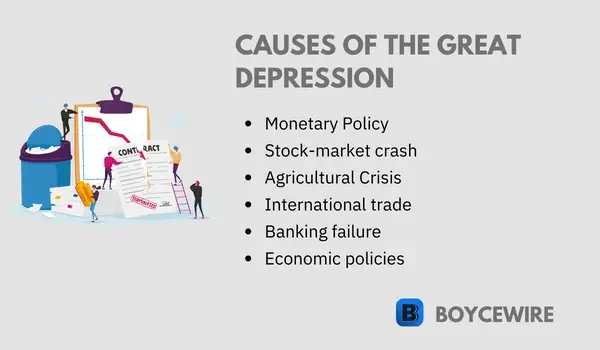Table of Contents ![]()
- Introduction
- 1. Stock Market Crash of 1929
- 2. Economic Policies and Practices
- 3. Banking System Failures
- 4. International Trade
- 5. Agricultural Sector Crisis
- 6. The Gold Standard and Monetary Policy
- The Impact of the Great Depression on Society
- Lessons Learned and the Legacy of the Great Depression
- Conclusion
- FAQs
Causes of the Great Depression

Introduction
The Great Depression, which lasted from 1929 to the late 1930s, was the most severe and prolonged economic downturn in modern history. It had a devastating impact on economies around the world, leading to widespread unemployment, poverty, and social unrest. Understanding the causes of the Great Depression is essential for policymakers and economists to learn from history and prevent similar crises in the future.
This article will delve into the various factors that contributed to the onset of the Great Depression, including the stock market crash of 1929, economic policies and practices, banking system failures, international trade policies, the agricultural sector crisis, and the role of the gold standard in monetary policy. By examining these causes, we can gain valuable insights into the complex interplay of factors that led to the most significant economic collapse of the 20th century.
Key Points
- The stock market crash of 1929 was a major trigger for the Great Depression, leading to a loss of confidence in the economy and a decline in consumer spending.
- Overproduction and overinvestment led to a surplus of goods and a decrease in demand, causing prices to fall and profits to decline.
- The use of credit to purchase goods led to an increase in consumer debt and a decrease in consumer spending, causing a contraction of the economy.
- The imposition of high tariffs and other trade barriers led to a decline in exports and a decrease in foreign investment, leading to a contraction of the economy.
1. Stock Market Crash of 1929
The Stock Market Boom
In the 1920s, the United States experienced a period of rapid economic growth and prosperity, known as the Roaring Twenties. This era was marked by technological advancements, increased consumer spending, and a booming stock market.
Many people, including ordinary citizens, began to invest in the stock market, often using borrowed money to buy stocks on margin. This speculative behavior led to a stock market bubble, with share prices reaching unsustainable levels.
The Black Tuesday Crash
On October 29, 1929, known as Black Tuesday, the stock market crashed, wiping out billions of dollars in wealth and signaling the beginning of the Great Depression. The crash was a result of several factors, including excessive speculation, margin buying, and a lack of regulation. As stock prices plummeted, panic set in, and investors rushed to sell their shares, further exacerbating the decline.
The Ripple Effect on the Economy
The stock market crash of 1929 had a domino effect on the US economy. As investors lost their savings and confidence in the financial system eroded, consumer spending and investment declined sharply. This led to a decrease in industrial production, job losses, and wage cuts, which in turn further reduced consumer spending.
The downward spiral of the economy intensified, with businesses going bankrupt and unemployment rates skyrocketing. The effects of the stock market crash were not limited to the United States, as the global economy was interconnected, and the crash reverberated around the world, contributing to the severity of the Great Depression.
2.Economic Policies and Practices
Laissez-faire Economic Policy
During the 1920s, the United States government generally adhered to a laissez-faire economic policy, which meant minimal intervention in the economy. This approach allowed for unregulated growth and contributed to the stock market boom.
However, the lack of oversight and regulation led to risky financial practices and the development of economic imbalances, such as income inequality and overproduction, which would eventually contribute to the Great Depression.
Income Inequality and Uneven Wealth Distribution
Income inequality in the United States reached extreme levels during the 1920s, with the majority of the wealth concentrated among a small percentage of the population.
The richest 1% owned approximately 40% of the nation’s wealth, while the bottom 90% of the population held only 16%. This uneven distribution of wealth limited the purchasing power of the majority of the population, which eventually resulted in reduced consumer spending and underconsumption.
Overproduction and Underconsumption
The rapid industrial growth during the 1920s led to overproduction in many industries, as businesses expanded their production capacities to meet the growing demand.
However, due to the uneven distribution of wealth and the limited purchasing power of most consumers, demand for goods could not keep up with the supply. This overproduction and underconsumption led to a buildup of inventories, forcing businesses to cut production, lay off workers, and reduce wages, which further depressed consumer spending and deepened the economic crisis.
3. Banking System Failures
Insufficient Regulation and Oversight
The banking system in the United States during the 1920s was characterized by insufficient regulation and oversight. Many banks engaged in risky lending practices, such as providing loans for stock market speculation and investing their depositors’ money in the stock market. The lack of a strong regulatory framework and the absence of deposit insurance left the banking system vulnerable to crises.
Bank Runs and Closures
As the economy faltered following the stock market crash, many people lost confidence in the banking system and began to withdraw their deposits, leading to bank runs.
Banks, unable to meet the demand for cash withdrawals due to their illiquid investments and loan defaults, were forced to close their doors. Between 1929 and 1933, approximately 9,000 banks in the United States failed, which further contracted the money supply and credit availability, exacerbating the economic downturn.
The Impact on the Money Supply and Credit
The banking system’s collapse had a significant impact on the money supply and credit availability in the economy. As banks failed, the money supply contracted, leading to deflation and a decrease in aggregate demand.
The lack of available credit made it difficult for businesses to borrow money for investments or to meet their financial obligations, forcing many to cut production, lay off workers, or close down entirely. This chain reaction intensified the economic crisis and contributed to the depth and duration of the Great Depression.
4. International Trade and the Smoot-Hawley Tariff Act
Global economic interconnectedness
The global economy in the 1920s was highly interconnected, with nations relying on international trade for economic growth. The United States, in particular, was a significant exporter and importer of goods.
As the U.S. economy began to decline following the stock market crash, the effects were felt worldwide, causing a slowdown in international trade and economic activity.
Protectionist policies and the Smoot-Hawley Tariff Act
In an attempt to protect domestic industries and encourage economic growth, the U.S. government enacted the Smoot-Hawley Tariff Act in 1930. This legislation imposed high tariffs on imported goods, making them more expensive for consumers and effectively reducing imports.
However, this protectionist policy backfired, as other countries retaliated by imposing their own tariffs on U.S. exports, leading to a decline in international trade.
Retaliation and the decline in global trade
The trade war sparked by the Smoot-Hawley Tariff Act had severe consequences for the global economy. As countries raised trade barriers in response to the U.S. tariffs, global trade declined dramatically. Between 1929 and 1933, the value of world trade fell by more than 60%. The collapse of international trade further deepened the economic crisis, contributing to the severity and duration of the Great Depression.
5. Agricultural Sector Crisis
Overproduction and falling crop prices
The agricultural sector in the United States faced significant challenges during the 1920s, even before the onset of the Great Depression. Rapid advancements in farming technology and increased production capabilities led to overproduction of crops. As supply outpaced demand, crop prices fell, making it difficult for farmers to make a profit and repay their debts.
Environmental factors: The Dust Bowl
Adding to the struggles of the agricultural sector, a severe drought hit the Great Plains region during the 1930s. The drought, combined with poor farming practices, led to widespread soil erosion and the creation of the Dust Bowl. The Dust Bowl forced thousands of farmers to abandon their land, further depressing the agricultural economy and increasing unemployment.
Impact on rural communities
The crisis in the agricultural sector had a profound impact on rural communities throughout the United States. As farm incomes declined and many farmers lost their land, rural banks faced a surge in loan defaults, leading to numerous bank failures. The decline in the agricultural sector also affected businesses and industries that relied on farmers as customers, contributing to the overall economic decline during the Great Depression.
6. The Gold Standard and Monetary Policy
The gold standard, a monetary system in which a country’s currency is directly convertible to a fixed amount of gold, played a significant role in the global economy during the 1920s and the Great Depression. Under the gold standard, central banks were required to maintain a certain level of gold reserves to back their currency, which constrained their ability to implement expansionary monetary policies to counteract economic downturns.
Contractionary monetary policy
During the onset of the Great Depression, the Federal Reserve, the U.S. central bank, implemented contractionary monetary policies to defend the gold standard. These policies included raising interest rates and reducing the money supply, which contributed to deflation, reduced consumer spending, and decreased investment. The contractionary monetary policies further worsened the economic crisis, prolonging the Great Depression.
Abandoning the gold standard
As the Great Depression persisted, countries began to abandon the gold standard in an effort to stimulate their economies. In 1933, the United States abandoned the gold standard and implemented expansionary monetary policies, which included lowering interest rates and increasing the money supply. These policies helped to stabilize the economy and eventually contributed to the recovery from the Great Depression. However, the delay in abandoning the gold standard prolonged the economic downturn and increased its severity.
The Impact of the Great Depression on Society
The Great Depression had devastating effects on society, with unemployment reaching unprecedented levels. At its peak in 1933, the unemployment rate in the United States was approximately 25%, with millions of people unable to find work. This widespread unemployment led to increased poverty, as families struggled to make ends meet.
As people lost their jobs and were unable to pay their mortgages or rent, homelessness became a significant issue during the Great Depression. Many individuals and families were forced to live in makeshift communities known as “Hoovervilles,” named after President Herbert Hoover, who was widely blamed for the crisis.
Additionally, the Dust Bowl and the decline of the agricultural sector prompted large-scale migration, particularly from the Great Plains region to California, in search of work and better living conditions.
The Great Depression had profound social and psychological effects on the American population. The pervasive sense of despair and hopelessness led to a decline in birth rates, an increase in suicide rates, and a general sense of disillusionment.
The crisis also exposed and exacerbated existing social inequalities, particularly along racial and gender lines, as minority populations and women often faced even greater challenges in finding work and accessing social services.
The severity of the Great Depression prompted a reevaluation of the role of government in society and led to the implementation of President Franklin D. Roosevelt’s New Deal programs.
These policies sought to alleviate the economic crisis through a combination of relief, recovery, and reform measures, including the establishment of social safety nets, infrastructure projects, and financial regulations. The New Deal marked a significant shift in American economic policy and laid the foundation for the modern welfare state.
Lessons Learned and the Legacy of the Great Depression
Financial regulation and oversight
One of the key lessons learned from the Great Depression was the importance of robust financial regulation and oversight. In response to the crisis, the U.S. government implemented several regulatory measures, such as the Glass-Steagall Act and the creation of the Securities and Exchange Commission, to prevent excessive risk-taking by banks and to ensure transparency and stability in the financial system.
Monetary and fiscal policy
The Great Depression highlighted the need for effective monetary and fiscal policy to counteract economic downturns. Central banks, including the Federal Reserve, adopted a more proactive approach to managing the money supply and interest rates to maintain economic stability. Additionally, governments increasingly turned to fiscal policy, such as government spending and taxation, to stimulate economic growth and mitigate the effects of recessions.
Social safety nets and the welfare state
The widespread suffering experienced during the Great Depression led to a greater recognition of the need for social safety nets to protect vulnerable populations. The New Deal programs, including Social Security, unemployment insurance, and public works projects, laid the foundation for the modern welfare state in the United States. These policies continue to play a crucial role in mitigating the effects of economic downturns and ensuring a basic standard of living for all citizens.
The role of government in the economy
The Great Depression sparked a debate about the appropriate role of government in the economy, which continues to shape political discourse today. The crisis challenged the prevailing laissez-faire economic policies of the time and led to increased government intervention to stabilize the economy and protect the well-being of citizens. This shift in economic policy has had lasting implications, as governments around the world continue to grapple with the balance between free-market capitalism and government intervention.
Conclusion
The Great Depression was a defining moment in modern economic history, leaving an indelible mark on society and shaping economic policies for decades to come. The crisis exposed the fragility of the global financial system, the consequences of unregulated markets, and the importance of effective government intervention in times of economic turmoil.
By examining the various causes of the Great Depression, including the stock market crash, bank failures, overproduction, the collapse of international trade, the agricultural sector crisis, and the constraints imposed by the gold standard, we can better understand the complex interplay of factors that led to the most severe economic downturn of the 20th century.
The lessons learned from the Great Depression have had a lasting impact, leading to the establishment of financial regulations, the adoption of more proactive monetary and fiscal policies, and the creation of social safety nets and the modern welfare state.
As we continue to face economic challenges and uncertainties in the 21st century, the experience of the Great Depression serves as a stark reminder of the importance of sound economic policies and responsible government intervention to ensure stability and prosperity for all.
FAQs
The main cause of the depression was the undersupply of money into the economy by the Federal Reserve. Its failure to match the strong economic growth of the 1920s meant that the amount of money in circulation did not reflect the goods and services provided within the economy. There was subsequently many more goods in the market, but not enough money to reflect them. This meant that goods were being overpriced, which led to the stock market crash and subsequent depression.
Other factors that contributed to the Great Depression included overproduction and overinvestment, the use of credit to purchase goods, a decline in international trade, a decrease in consumer spending, and bank failures.
The stock market crash of 1929 led to a loss of confidence in the economy and a decline in consumer spending, as many people saw their savings and investments disappear overnight. This led to a contraction of the economy and a decline in industrial production.
Overproduction and overinvestment led to a surplus of goods and a decrease in demand, which caused prices to fall and profits to decline. This, in turn, led to a decrease in industrial production and an increase in unemployment.
The use of credit to purchase goods led to an increase in consumer debt and a decrease in consumer spending, as people had to divert more of their income to paying off their debts. This, in turn, led to a contraction of the economy and a decline in industrial production.
About Paul
Paul Boyce is an economics editor with over 10 years experience in the industry. Currently working as a consultant within the financial services sector, Paul is the CEO and chief editor of BoyceWire. He has written publications for FEE, the Mises Institute, and many others.

Further Reading
 Anova - ANOVA (Analysis of Variance) is a statistical technique used to compare means across multiple groups and determine if there are…
Anova - ANOVA (Analysis of Variance) is a statistical technique used to compare means across multiple groups and determine if there are…  Public Goods: Definition, Characteristics & Examples - A public good is a good whereby no individual can be excluded from benefiting from it. In other words, everyone…
Public Goods: Definition, Characteristics & Examples - A public good is a good whereby no individual can be excluded from benefiting from it. In other words, everyone…  Contribution Margin - The contribution margin is a financial metric that represents the amount of revenue available to cover fixed costs and contribute…
Contribution Margin - The contribution margin is a financial metric that represents the amount of revenue available to cover fixed costs and contribute… 
